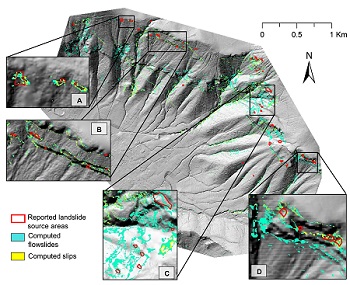Mechanics of Fluid-Saturated Porous Media for Geohazard Assessment
Northwestern University
Problems
Geomaterials are porous, discrete and heterogeneous media continuously exposed to interactions with the environment. These solids host multiple fluids, with which they establish physical and chemical interactions. As a result, natural and human-induced fluctuations in environmental conditions change their strength and deformation properties, thus playing a key role in a number of applications, such as the forecasting of natural hazards, the management of infrastructures, the optimization of energy technologies and the underground disposal of hazardous substances. The goal of our group is to gain a fundamental insight into the mechanics of geomaterials, as well as into the natural and technological systems that are controlled by their stress-strain response. Our long-term objective is to strengthen the impact of geomechanics in the interpretation, management and mitigation of geological, environmental and energy-related risks, i.e. societal challenges in which the multi-physical processes taking place in earthen materials play a pivotal role.
Approach
Our research focuses on the interaction between mechanical processes and the environmental agents which may cause unstable deformations in natural deposits. The emphasis of our research is on the effect of multi-physical interactions on the inelastic behavior of porous geological solids. Specifically, we address the role of multi-phase flow and reaction-transport by incorporating their effects into non-linear constitutive models for geomaterials, as well as by inspecting the mathematical implications of environmental perturbations. The problems that we address span multiple-length scales, from the microscopic compounds forming soils and rocks to the natural slopes that constitute a landscape and interact with infrastructures.

Findings
By using plasticity models for unsaturated soils and principles of material stability we derived a second-order energy measure for unsaturated porous media, as well as controllability thresholds for different types of failure. This has allowed us to take into account the role of changes in capillary pressure suction and moisture content in material stability analyses, thus differentiating the initiation conditions of frictional slips of limited mobility and those associated with the initiation of runaway failures promoted by soil liquefaction. Such findings have been incorporated into predictive models for landslide hazard assessment, which are capable of mapping the spatiotemporal progression of the triggering of life-threatening landslides.
Impact
This research can enhance our ability to locate different forms of slope failures via physically-based models, as well as to assess the impact of changing climate patterns on the hazard exposure of densely populated urban settings. The incorporation of principles of geomechanics into the practice of landslide forecasting has broad societal impacts in terms of risk assessment and land-use planning and can impact a broad range of problems dominated by the interplay between human activities and natural processes in the near-surface.
Core competencies
- Constitutive Modeling
- Geomechanics
- Poromechanics of Unsaturated Soils
- Material Stability
- Geohazard Forecasting
Current research team members
- Giuseppe Buscarnera (PI)
- Changbum Sohn (Graduate student)
- Ghassan Shahin (Graduate student)
- Yanni Chen (Graduate student)
- Xiang Li (Graduate student)
- Dawa Seo (Graduate student)
- Ritaja Rai (Graduate student)
- Karla Lopez (Undergraduate student)
- Alex Toporek (Undergraduate student)


